Feb 6, 2023
Growth spurt: New state-of-the-art greenhouse to power microgreens operation
Robbie McClam has an odd idea of retirement. After a successful career in architecture and development, McClam found his attention drawn back to the agricultural interests that led to him to consider changing his field of study at Clemson University.
Inspired by the story of Will Allen, a South Carolina native whose work in urban farming and sustainable food production in Milwaukee led to a MacArthur Foundation “Genius Grant,” McClam decided to try something similar in his home state.
That led to the 2009 founding of City Roots Organic Farm in Columbia, S.C. The operation he runs with his son Eric has steadily become a state and regional go-to for microgreens for restaurant and retail customers and is poised for breakout growth with the construction of a new 73,000-square-foot, state-of-the-art greenhouse.
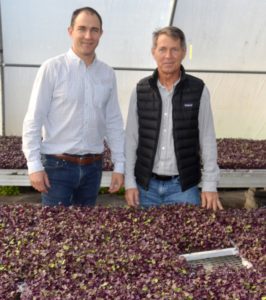
“I thought about changing my degree from architecture, back when I was at Clemson, to horticulture,” the elder McClam said. “I used to hang out in the greenhouses on weekends and all that stuff, but I never quite pulled the trigger. Just waited a couple of decades and then got there.”
Robbie McClam is quick to credit Eric — who also has an architecture degree, from Tulane University, and was recruited by his father to help start the farm — with City Roots’ growth.
“If it weren’t for Eric, we’d be just down here pulling weeds in one little greenhouse,” Robbie said. “He’s really made it grow. It’s been exciting and a very pleasant surprise. Looking at where we are now and what we see in the potential future, I’m really excited.”
That future includes increased distribution through in-the-works agreements with New York-headquartered Baldor Specialty Foods and the Atlanta division of Sprouts Farmers Market grocers. Currently a supplier to Whole Foods and US Foods along with local restaurants and chefs, City Roots has no shortage of customers — just limited space.
“Between the retailers that we’ve got some commitments from and the food service groups that we’ve got commitments from, we may fill out the whole greenhouse in year one,” Eric McClam said. “We thought it might take two to three years. It’s a good issue to have, and now it’s a matter of getting the greenhouse built and getting it filled with microgreens.”
The new facility, manufactured by Canadian greenhouse company Cravo, purchased online by the McClams and shipped in pieces from its previous owner in New Jersey, is the key to ramping up production. The greenhouse, which is around one-third complete on 90 acres a few miles from City Roots’ current location, will feature six 360-foot bays, each with 24 controlled growing zones, that will more than double the farm’s current 13-greenhouse, 30,000-square-foot footprint.
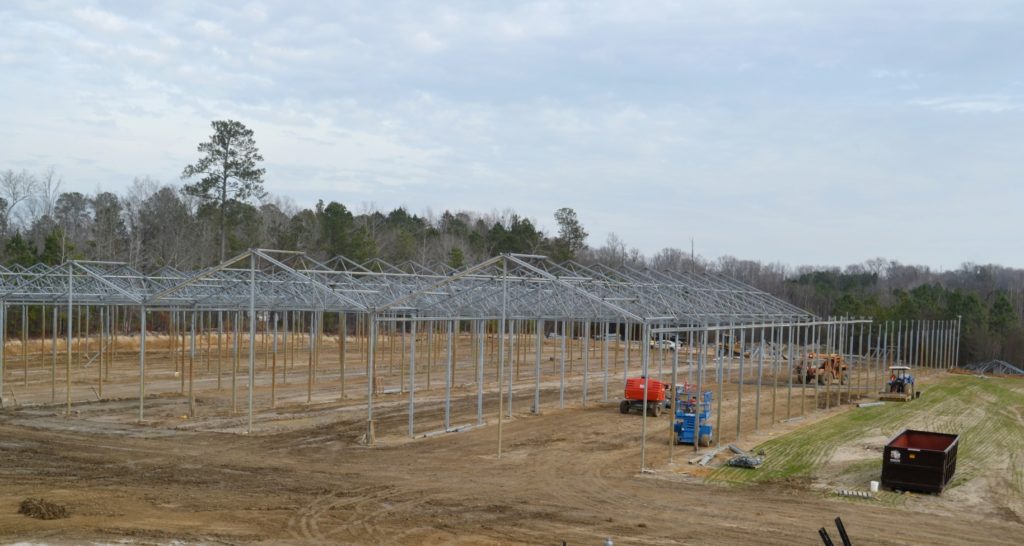
The greenhouse’s technological amenities will include a retractable roof and side walls, a black plate sensor to detect radiant temperature, computer-controlled geothermal heating that will warm the soil and air simultaneously, boom irrigation, and natural gas boilers that will allow for the collection and redistribution of C02 to promote photosynthesis.
Lighting the way
Another crucial component to increasing production in the new greenhouse will be supplemental lighting. Controlled by quantum sensors to measure photosynthetically active radiation (PAR), the upgraded lighting system will replace City Roots’ high pressure sodium fixtures, most of which are around 400 watts, with 680-watt LED lights which produce three times the amount of lumens (which measure light intensity) and micromoles (which count photons).
Right now, “we just turn lights on and off if we’ve got bad weather,” Eric McClam said. “They don’t turn on at night unless we keep them on. We’re not as efficient as we might be with the grow lights here. Grow lights are going to be adding full-spectrum light to the leafy greens to allow for them to grow more rapidly and to photosynthesize more.”
Rose Séguin’s job as an agronomist at Canada-based light manufacturer Sollum Technologies is to introduce greenhouse growers to such technological benefits.
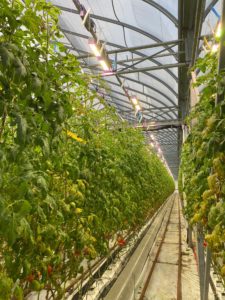
“When you start adding light, you can increase the weight of the product, but you can also shorten the cycle,” she said. “As a grower, I might be going from 40 days in the winter to 28, and so ultimately, I get more (cycles) in a year. It’s a more efficient use of your space and it gives you a chance to make more money as well.”
Séguin works with customers, such as The Chef’s Garden in Huron, Ohio, and Les Serres Point du Jour in Quebec, Canada, ahead of and after the installation of dynamic LED lighting systems to hammer out a plan and monitor its results.
“What the plan consists of is your light intensity, how long you’re going to keep the lights on a day, and also your scheduling,’ she said. “In inclement weather, that’s helpful, but also we’ve got the ability to turn them on and run them for a more appropriate amount of time in the new greenhouse.”
Les Serres Point du Jour established nine greenhouses on two acres in August 2022 — just in time, as it turned out. When the province experienced its poorest month for sunlight in 25 years in December, the 1,842-light system designed by Sollum cut down on lost crop production, CEO Robert Therien said.
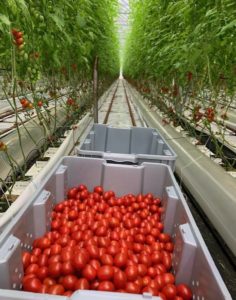
The company, which produces between 8,000 and 12,000 pounds of specialty tomatoes per week, lost 10% to 15% of that production instead of 50% to 60%, Therien said.
The McClams are also eager to shine more light on their plants during the winter, when days can have less than 10 hours of natural light, as well as during non-peak hours of electricity consumption as they strive to make their new facility carbon-neutral.
The lighting intensity required by microgreens is fairly consistent, the McClams said. Some varieties, such as red mustard greens or purple Rambo radishes, require greater intensity to achieve their desired color.
City Roots’ new lighting system, manufactured by an S.C. company, will result in a facility that is two to 2.25 times more efficient that its current operation, said Trey Daniels of Daniels Engineering Services in Columbia, which worked on the project.
Greenhouse zones like the ones City Roots is planning can also add to growers’ flexibility and increase crop production.
“If you have a variety that doesn’t need 18 hours (of light), why give it 18 hours?” Séguin said. “Say we want our target to be 400 micromoles, for example. If the sun is giving me 400-plus, the lights shut off. If the sun is giving me 300, the lights will give 100. In that way, you’re never giving too much light, so for the crop health side of things, you’re getting a uniform light level. Also you’re only applying as much energy as you need to make your target.”
Controlled lighting also has applications managing pests and pathogens, with nascent research producing promising results, Séguin said.
“So far we’ve seen some positive effects,” she said. “We would like to see it more throughout the entire season to really follow that trend to see how it works and hopefully be able to replicate it in the coming years.”
While Sollum has typically worked with growers of peppers, cucumbers and tomatoes, Séguin said market diversification is expanding to include strawberries, eggplant and cannabis.
“The importance of bringing all this together is that sometimes you’ll notice something happening in your crop, and if you can actually refer to the climate, refer to the light levels, you can get a little bit closer to figuring out what it is and ruling certain things out,” she said. “The goal is to take as much data as the grower has and pull it all together with ours so that they can make really informed decisions.”
Finding a niche
City Roots’ current crops include arugula, broccoli, kale, radish, mustard greens, cilantro, and snow peas, along with the sunflowers that stem from the McClams’ early experimental efforts.
“At one point, we were growing a dozen acres of vegetables, a couple acres of cut flowers,’ Eric McClam said. “We were doing mushroom production, microgreen production, agrotourism. Then at a certain point a couple of years ago, we said let’s pull this back. Let’s focus on what we are most well-known for, which are the microgreens and leafy greens.”
City Roots was always committed to obtaining organic certification, Eric said, and its soil is certified under the Real Organic project. The farm is also GAP (Good Agricultural Practices)- certified for food safety.
“The rigors of (those processes) really show to the general public, or our buyers or our vendors, that we do what we say we do,” Eric said.
Another City Roots tenet is soil-based farming. To that end, the new facility will include more compost sheds to help maintain the farm’s living soil, currently being analyzed by University of South Carolina soil scientist Buz Kloot for a better understanding of its microbe activity.
City Roots’ soil is run through a tray filler, a water tunnel and an automated seeder, then topped with a coat of vermiculite before being left to germinate. At the new greenhouse, a conveyor belt will funnel the trays through different growing zones to their eventual destination: a full-service harvester.
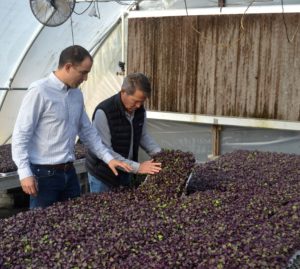
“Fundamentally, soil is the structure of our planet and our production. Philosophically, for us, it’s really important to maintain that,” Eric said.
The new facility, situated near an industrial park on land purchased from Richland County, will include a washing and packaging operation, loading docks and cold storage, as well as a solar array that will reduce City Roots’ energy costs by 30%.
The operation will also create around 50 jobs when up and running, Eric said.
The McClams will maintain ownership of the original farm, renting out its commercial kitchen and leasing its greenhouses.
The evolution of City Roots from Robbie McClam’s retirement project into a regional player in the microgreens market draws a wry smile from the elder McClam, who met with initial resistance to the idea of focusing on the microgreens that he saw as “a controlled profit center.”
“(Eric would say), ‘No, I want to be a farmer. I want to grow everything,’ ” Robbie said. “We finally got a good focus and we’ve gotten pretty good at what we’re doing. We’re pretty proud of that.”






